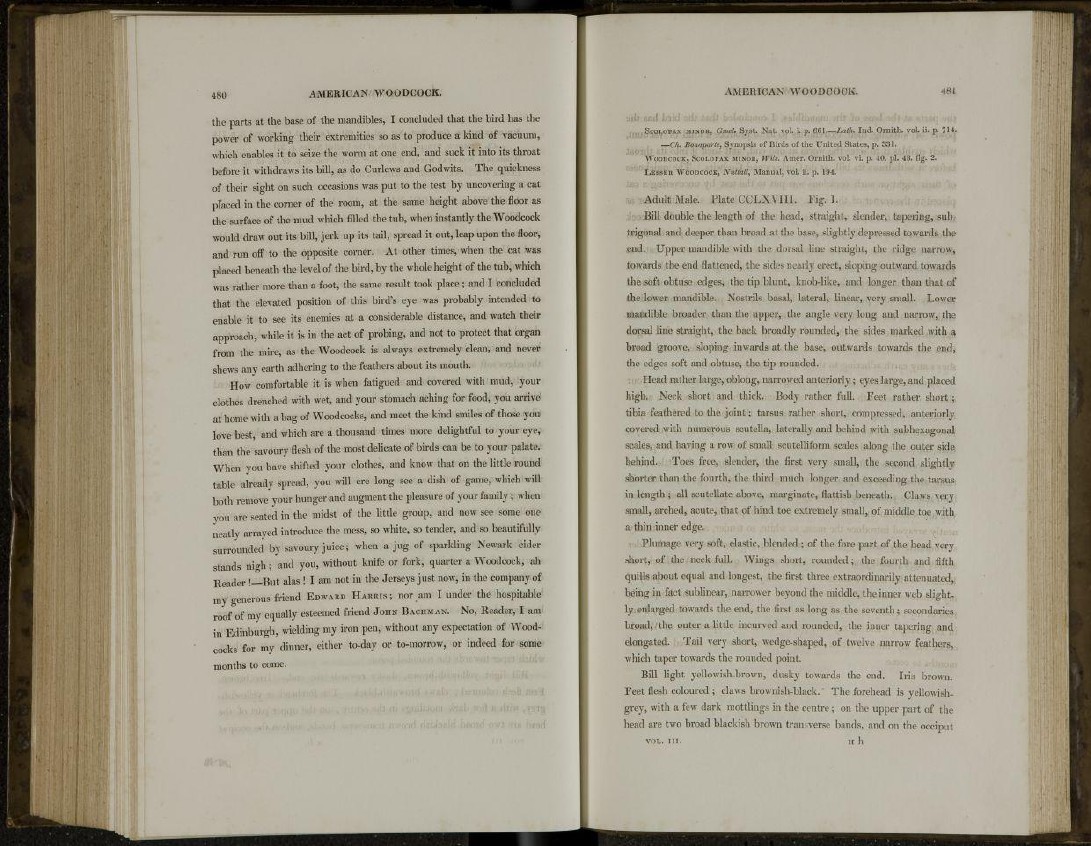
the parts at the base of the mandibles, I concluded that the bird has the
power of working their extremities so as to produce a kind of vacuum,
which enables it to seize the worm at one end, and suck it into its throat
before it withdraws its bill, as do Curlews and Godwits. The quickness
of their sight on such occasions was put to the test by uncovering a cat
placed in the corner of the room, at the same height above the floor as
the surface of the mud which filled the tub, when instantly the Woodcock
would draw out its bill, jerk up its tail, spread it out, leap upon the floor,
and run off to the opposite corner. At other times, when the cat was
placed beneath the level of the bird, by the whole height of the tub, which
was rather more than a foot, the same result took place; and I concluded
that the elevated position of this bird's eye was probably intended to
enable it to see its enemies at a considerable distance, and watch their
approach, while it is in the act of probing, and not to protect that organ
from the mire, as the Woodcock is always extremely clean, and never
shews any earth adhering to the feathers about its mouth.
How comfortable it is when fatigued and covered with mud, your
clothes drenched with wet, and your stomach aching for food, you arrive
at home with a bag of Woodcocks, and meet the kind smiles of those you
love best, and which are a thousand times more delightful to your eye,
than the savoury flesh of the most delicate of birds can be to your palate.
When you have shifted your clothes, and know that on the little round
table already spread, you will ere long see a dish of game, which will
both remove your hunger and augment the pleasure of your family ; when
you are seated in the midst of the little group, and now see some one
neatly arrayed introduce the mess, so white, so tender, and so beautifully
surrounded by savoury juice; when a jug of sparkling Newark cider
stands nigh ; and you, without knife or fork, quarter a Woodcock, ah
Reader !—Rut alas ! I am not in the Jerseys just now, in the company of
my generous friend EDWARD HARMS; nor am I under the hospitable
roof of my equally esteemed friend JOHN BACHMAN. No, Reader, I am
in Edinburgh, wielding my iron pen, without any expectation of Woodcocks
for my dinner, either to-day or to-morrow, or indeed for some
months to come.
SCOI.OPAX MINOR, Gmcl. Syst. Xat. vol. i p. G61—Lath. Ind. Ornith. vol. ii. p. 714.
Ch. Bonaparte, Synopsis of Birds of the United States, p. 331.
WOODCOCK, SCOLOTAX MINOR, Wils. Amer. Ornith. vol. vi. p. 40. pi. 48. fig. 2.
LESSER WOODCOCK, Nuttall, Manual, vol. ii. p. 194.
Adult Male. Plate CCLXVIII. Fig. 1.
Bill double the length of the head, straight, slender, tapering, sub
trigonal and deeper than broad at the base, slightly depressed towards the
end. Upper mandible with the dorsal line straight, the ridge narrow,
towards the end flattened, the sides nearly erect, sloping outward towards
the soft obtuse edges, the tip blunt, knob-like, and longer than that of
the lower mandible. Nostrils basal, lateral, linear, very small. Lower
mandible broader than the upper, the angle very long and narrow, the
dorsal line straight, the back broadly rounded, the sides marked with a
broad groove, sloping inwards at the base, outwards towards the end,
the edges soft and obtuse, the tip rounded.
Head rather large, oblong, narrowed anteriorly ; eyes large, and placed
high. Neck short and thick. Body rather full. Feet rather short ;
tibia feathered to the joint; tarsus rather short, compressed, anteriorly
covered with numerous scutella, laterally and behind with subhexagonal
scales, and having a row of small scutelliform scales along the outer side
behind. Toes free, slender, the first very small, the second slightly
shorter than the fourth, the third much longer and exceeding the tarsus
in length ; all scutellate above, margínate, flattish beneath. Claws very
small, arched, acute, that of hind toe extremely small, of middle toe with
a thin inner edge.
Plumage very soft, elastic, blended ; of the fore part of the head very
short, of the neck full. Wings short, rounded; the fourth and fifth
quills about equal and longest, the first three extraordinarily attenuated,
being in fact sublinear, narrower beyond the middle, the inner web slightly
enlarged towards the end, the first as long as the seventh; secondaries
broad, the outer a little incurved and rounded, the inner tapering and
elongated. Tail very short, wedge-shaped, of twelve narrow feathers,
which taper towards the rounded point.
Bill light yellowish-brown, dusky towards the end. Iris brown.
Feet flesh coloured ; claws brownish-black.' The forehead is yellowishgrey,
with a few dark mottlings in the centre; on the upper part of the
head are two broad blackish brown transverse bands, and on the occiput
VOL. in. H h